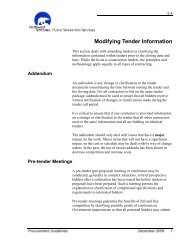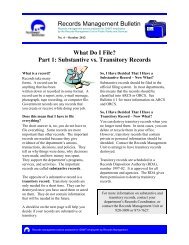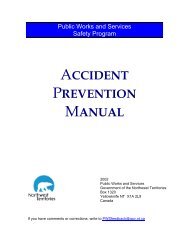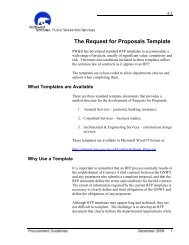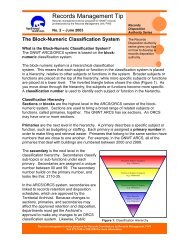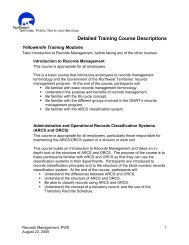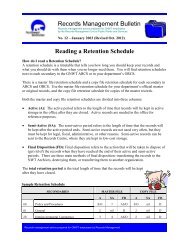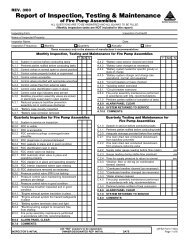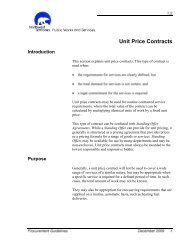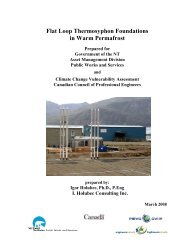- Page 1 and 2: Small Systems Water Treatment Plant
- Page 3 and 4: SMALL SYSTEMS INTRODUCTION 4.7.4 Pr
- Page 5 and 6: SMALL SYSTEMS INTRODUCTION 10.4.1 C
- Page 7 and 8: SMALL SYSTEMS INTRODUCTION 1.0 INTR
- Page 9 and 10: SMALL SYSTEMS INTRODUCTION Addition
- Page 11 and 12: SMALL SYSTEMS INTRODUCTION Notes 11
- Page 13 and 14: SMALL SYSTEMS REGULATIONS EGULATION
- Page 15 and 16: SMALL SYSTEMS REGULATIONS EGULATION
- Page 17 and 18: SMALL SYSTEMS REGULATIONS EGULATION
- Page 19: SMALL SYSTEMS WATER SOURCES & CHARA
- Page 23 and 24: SMALL SYSTEMS WATER SOURCES & CHARA
- Page 25 and 26: SMALL SYSTEMS WATER SOURCES & CHARA
- Page 27 and 28: SMALL SYSTEMS WATER SOURCES & CHARA
- Page 29 and 30: SMALL SYSTEMS WATER SOURCES & CHARA
- Page 31 and 32: SMALL SYSTEMS WATER SOURCES & CHARA
- Page 33 and 34: SMALL SYSTEMS WATER SOURCES & CHARA
- Page 35 and 36: SMALL SYSTEMS SYSTEM COMPON OMPONEN
- Page 37 and 38: SMALL SYSTEMS SYSTEM COMPON OMPONEN
- Page 39 and 40: SMALL SYSTEMS SYSTEM COMPON OMPONEN
- Page 41 and 42: SMALL SYSTEMS 4.6.2.2 Submersible S
- Page 43 and 44: SMALL SYSTEMS SYSTEM COMPON OMPONEN
- Page 45 and 46: SMALL SYSTEMS SYSTEM COMPON OMPONEN
- Page 47 and 48: SMALL SYSTEMS SYSTEM COMPON OMPONEN
- Page 49 and 50: SMALL SYSTEMS Figure 4-10 NRS Gate
- Page 51 and 52: SMALL SYSTEMS SYSTEM COMPON OMPONEN
- Page 53 and 54: SMALL SYSTEMS SYSTEM COMPON OMPONEN
- Page 55 and 56: SMALL SYSTEMS SYSTEM COMPON OMPONEN
- Page 57 and 58: SMALL SYSTEMS DISINFECTION 5 5.4 HO
- Page 59 and 60: SMALL SYSTEMS DISINFECTION too much
- Page 61 and 62: SMALL SYSTEMS DISINFECTION 5 5.8 WH
- Page 63 and 64: SMALL SYSTEMS DISINFECTION 5 Office
- Page 65 and 66: SMALL SYSTEMS DISINFECTION 5 Table
- Page 67 and 68: SMALL SYSTEMS DISINFECTION Now assu
- Page 69 and 70: SMALL SYSTEMS DISINFECTION Note tha
- Page 71 and 72:
SMALL SYSTEMS Answer: V 1 is 250 ml
- Page 73 and 74:
SMALL SYSTEMS DISINFECTION 5 5.13 R
- Page 75 and 76:
SMALL SYSTEMS MAINTENANCE FOR WATER
- Page 77 and 78:
SMALL SYSTEMS MAINTENANCE FOR WATER
- Page 79 and 80:
SMALL SYSTEMS MAINTENANCE FOR WATER
- Page 81 and 82:
SMALL SYSTEMS MAINTENANCE FOR WATER
- Page 83 and 84:
SMALL SYSTEMS MAINTENANCE FOR WATER
- Page 85 and 86:
SMALL SYSTEMS MAINTENANCE FOR WATER
- Page 87 and 88:
SMALL SYSTEMS MAINTENANCE FOR WATER
- Page 89 and 90:
SMALL SYSTEMS MAINTENANCE FOR WATER
- Page 91 and 92:
SMALL SYSTEMS MAINTENANCE PROCEDURE
- Page 93 and 94:
SMALL SYSTEMS MAINTENANCE PROCEDURE
- Page 95 and 96:
SMALL SYSTEMS MAINTENANCE PROCEDURE
- Page 97 and 98:
SMALL SYSTEMS MAINTENANCE PROCEDURE
- Page 99 and 100:
SMALL SYSTEMS MAINTENANCE PROCEDURE
- Page 101 and 102:
SMALL SYSTEMS MAINTENANCE PROCEDURE
- Page 103 and 104:
SMALL SYSTEMS MAINTENANCE PROCEDURE
- Page 105 and 106:
SMALL SYSTEMS MAINTENANCE PROCEDURE
- Page 107 and 108:
SMALL SYSTEMS MAINTENANCE PROCEDURE
- Page 109 and 110:
SMALL SYSTEMS 7.15.8 ACTIVATED CARB
- Page 111 and 112:
SMALL SYSTEMS MAINTENANCE PROCEDURE
- Page 113 and 114:
SMALL SYSTEMS WASTE SOURCES OURCES,
- Page 115 and 116:
SMALL SYSTEMS WASTE SOURCES OURCES,
- Page 117 and 118:
SMALL SYSTEMS WASTE SOURCES OURCES,
- Page 119 and 120:
SMALL SYSTEMS WASTE SOURCES OURCES,
- Page 121 and 122:
SMALL SYSTEMS SEWA EWAGE LAGOON OPE
- Page 123 and 124:
SMALL SYSTEMS SEWA EWAGE LAGOON OPE
- Page 125 and 126:
SMALL SYSTEMS SEWA EWAGE LAGOON OPE
- Page 127 and 128:
SMALL SYSTEMS SEWA EWAGE LAGOON OPE
- Page 129 and 130:
SMALL SYSTEMS SEWA EWAGE LAGOON OPE
- Page 131 and 132:
SMALL SYSTEMS SEWA EWAGE LAGOON OPE
- Page 133 and 134:
SMALL SYSTEMS SEWA EWAGE LAGOON OPE
- Page 135 and 136:
SMALL SYSTEMS SEWA EWAGE LAGOON OPE
- Page 137 and 138:
SMALL SYSTEMS SEWA EWAGE LAGOON OPE
- Page 139 and 140:
SMALL SYSTEMS SEWA EWAGE LAGOON OPE
- Page 141 and 142:
SMALL SYSTEMS SEWA EWAGE LAGOON OPE
- Page 143 and 144:
SMALL SYSTEMS SEWA EWAGE LAGOON OPE
- Page 145 and 146:
SMALL SYSTEMS SEWA EWAGE LAGOON OPE
- Page 147 and 148:
SMALL SYSTEMS SOLID WASTE OPERATOR
- Page 149 and 150:
SMALL SYSTEMS MANAGEMENT AND OPERAT
- Page 151 and 152:
SMALL SYSTEMS MANAGEMENT AND OPERAT
- Page 153 and 154:
SMALL SYSTEMS MANAGEMENT AND OPERAT
- Page 155 and 156:
SMALL SYSTEMS MANAGEMENT AND OPERAT
- Page 157 and 158:
SMALL SYSTEMS MANAGEMENT AND OPERAT
- Page 159 and 160:
SMALL SYSTEMS MAINTENANCE PROCEDURE
- Page 161 and 162:
SMALL SYSTEMS MAINTENANCE PROCEDURE
- Page 163 and 164:
SMALL SYSTEMS MAINTENANCE PROCEDURE
- Page 165 and 166:
SMALL SYSTEMS MAINTENANCE PROCEDURE
- Page 167 and 168:
SMALL SYSTEMS MAINTENANCE PROCEDURE
- Page 169 and 170:
ADDENDUM A MATH TOPICS
- Page 171 and 172:
METRICS: Scientists and many other
- Page 173 and 174:
CONVERSION TABLE: when you know mul
- Page 175 and 176:
EXAMPLE CALCULATIONS FOR WATER TREA
- Page 177 and 178:
PERCENT EXAMPLE 1 A lime solution h
- Page 179 and 180:
Weir overflow rate = flow (L/s) wei
- Page 181 and 182:
Then we divide: 96 000 L = 29.1 L/s
- Page 183 and 184:
This tells you that chlorine gas is
- Page 185 and 186:
CHEMICAL FEEDING Solution Preparati
- Page 187 and 188:
tank is 11 L/s, what is the average
- Page 189 and 190:
FILTER LOADING RATE The "filter loa
- Page 191 and 192:
Filter backwash rates, as noted ear
- Page 193 and 194:
Req'd dosages mL of solution = 5 mg
- Page 195 and 196:
mL/min = (Dosage mg/L) (Flow/l 000
- Page 197:
ADDENDUM B ABC NEED-TO-KNOW
- Page 221:
ADDENDUM D GUIDELINES FOR CANADIAN
- Page 270 and 271:
PUBLIC HEALTH ACT CONSOLIDATION OF
- Page 272 and 273:
purposes. (citerne de transport d'e
- Page 274 and 275:
water to meet the demand of a commu
- Page 276 and 277:
Arsenic (As) 0.05 Chloride (Cl) 250
- Page 278 and 279:
groundwater source if the water may
- Page 280 and 281:
d'un mur extérieur ou à un endroi
- Page 282 and 283:
consumption of fluorides and volume
- Page 284 and 285:
disposal field or other similar sou
- Page 286 and 287:
Water Mains Conduites d'eau princip
- Page 288 and 289:
(13)There shall be no physical conn
- Page 290 and 291:
ADDENDUM F SAMPLE WATER LICENCE
- Page 292 and 293:
(S) (S) (S) (S) (S) (S) (S) (S) (S)
- Page 294 and 295:
efunded by the Minister pursuant to
- Page 296 and 297:
(S) The Licensee shall obtain all w
- Page 298 and 299:
(S) Modifications for which all of
- Page 300 and 301:
shall be submitted to the Board for
- Page 302 and 303:
10) alternatives designed to reduce
- Page 304 and 305:
(S) (S) All sampling, sample preser
- Page 306 and 307:
than four analytical results, the d
- Page 308 and 309:
5. The Licensee shall maintain all
- Page 310 and 311:
) such modifications do not place t
- Page 312 and 313:
after initially reporting the event
- Page 314 and 315:
ADDENDUM G CWMS WATER DISTRIBUTION
- Page 316 and 317:
Community Works Management System T
- Page 318 and 319:
Community Works Management System T
- Page 320 and 321:
Community Works Management System T
- Page 322 and 323:
Community Works Management System T
- Page 324 and 325:
Community Works Management System T
- Page 326 and 327:
Community Works Management System T
- Page 328 and 329:
Community Works Management System T
- Page 330 and 331:
Community Works Management System T
- Page 332 and 333:
Community Works Management System T
- Page 334 and 335:
Community Works Management System T
- Page 336 and 337:
Community Works Management System T
- Page 338 and 339:
Community Works Management System T
- Page 340 and 341:
Community Works Management System T
- Page 342 and 343:
Community Works Management System T
- Page 344 and 345:
Community Works Management System T
- Page 346 and 347:
Community Works Management System T
- Page 348 and 349:
Community Works Management System T
- Page 350 and 351:
Community Works Management System T
- Page 352 and 353:
Community Works Management System T
- Page 354 and 355:
Community Works Management System T
- Page 356 and 357:
Community Works Management System T
- Page 358 and 359:
Community Works Management System T
- Page 360 and 361:
Community Works Management System T
- Page 362 and 363:
Community Works Management System T
- Page 364 and 365:
Community Works Management System T
- Page 366 and 367:
Community Works Management System T
- Page 368 and 369:
Community Works Management System T
- Page 370 and 371:
Community Works Management System T
- Page 372 and 373:
Community Works Management System T
- Page 374 and 375:
Community Works Management System T
- Page 376 and 377:
Community Works Management System T
- Page 378 and 379:
HYDRITE CHEMICAL CO -- SODIUM HYPOC
- Page 380 and 381:
ESTABLISHED BY RESPIRATOR MANUFACTU
- Page 382 and 383:
IMO Packaging Group: II/III Subsidi
- Page 384 and 385:
CAROLINA BIOLOGICAL SUPPLY CO -- 88
- Page 386 and 387:
Hazardous Polymerization Indicator:
- Page 388 and 389:
MSDS Number: C2046 * * * * * Effect
- Page 390 and 391:
Fire: As with most organic solids,
- Page 392 and 393:
Stability: Stable under ordinary co
- Page 394 and 395:
Label First Aid: If inhaled, remove
- Page 396 and 397:
Emergency Overview ----------------
- Page 398 and 399:
2 mg/m3 (TWA) soluble salts as Al V
- Page 400 and 401:
federal disposal regulations. Dispo
- Page 402 and 403:
MSDS Number: A5472 * * * * * Effect
- Page 404 and 405:
Skin Contact: Immediately flush ski
- Page 406 and 407:
Specific Gravity: ca. 0.90 @ 25C/25
- Page 408 and 409:
--Canada-- Ingredient Korea DSL NDS
- Page 410 and 411:
GREAT WESTERN CHEMICAL CO -- CAUSTI
- Page 412 and 413:
SWELL, & PAIN. EXPOS MAY CAUSE CORN
- Page 414 and 415:
Fire Hazard: None Reactivity Hazard
- Page 416 and 417:
YIELDING HYDROCHLORIC ACID. SKIN BU
- Page 418 and 419:
PRESSURE-REDUCING REGULATOR WHEN CO
- Page 420 and 421:
HARCROS CHEMICALS INC. -- HYDROFLUO
- Page 422 and 423:
Eye Protection: SPLASH-PROOF SAFETY
- Page 424 and 425:
===================================
- Page 426 and 427:
Cas: 1305-62-0 RTECS #: EW2800000 N
- Page 428 and 429:
Solubility in Water: APPROXIMATELY
- Page 430 and 431:
===================================
- Page 432 and 433:
-------------------------- DANGER!
- Page 434 and 435:
8. Exposure Controls/Personal Prote
- Page 436 and 437:
This material is not expected to si
- Page 438 and 439:
Do not breathe dust. Keep container
- Page 440 and 441:
Contacts & Additional Sources of In
- Page 442 and 443:
17) Algal in water Supplies _ U .S
- Page 444 and 445:
GLOSSARY ABS- Abbreviation for Sodi
- Page 446 and 447:
Chloramines Compounds formed by the
- Page 448 and 449:
Hydrogen Sulphide It is a gas with
- Page 450 and 451:
Pathogens Disease producing bacteri
- Page 452 and 453:
Suspended solids 1) Solids that eit



